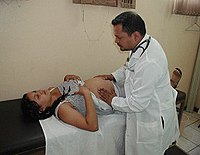
Photo from wikipedia
Background While women experiencing intimate partner violence (IPV) face significant health consequences, their patterns of healthcare services (HCS) utilization are unclear, as are the effects of IPV screening and receiving… Click to show full abstract
Background While women experiencing intimate partner violence (IPV) face significant health consequences, their patterns of healthcare services (HCS) utilization are unclear, as are the effects of IPV screening and receiving information on these patterns. Objectives 1. Compare utilization patterns of five HCS (visits to family physician, gynecologist, specialist and emergency room, and hospitalization) in a cohort of perinatal women who reported experiencing versus not experiencing any IPV and IPV types (physical and/or sexual; emotional and/or verbal; social and economic); 2. Examine whether IPV screening, receiving information on support services, or both, affect patterns; and 3. Compare these associations between ethnic groups (Arab and Jewish women). Methods We conducted a prospective study using registry data on HCS utilization obtained from Israel’s largest Health Fund (Clalit) in the year following a 2014–2015 survey of a cohort of 868 perinatal women in Israel (327 Arab minority, 542 Jewish) on their reports of experiencing IPV, IPV screening, and receiving information. Using multivariate analysis, we calculated adjusted odds ratios (AOR) and 95% confidence intervals (CI) for the five HCS utilizations in association with reports of any IPV and IPV types. We adjusted for IPV screening, receiving information about services, and both, in the total sample, and separately among ethnic groups. Results Any IPV and IPV types had significant associations with some HCS utilization variables, with different directions and patterns for the ethnic groups. Experiencing IPV was associated with higher HCS utilization among Arab women, lower utilization in Jewish women. Arab women experiencing IPV were twice as likely to visit a gynecologist than women not experiencing IPV (AOR (95% CI) was 2.00, 1.14–3.51 for any IPV; 2.17, 1.23–3.81 for emotional and/or verbal IPV, and 1.83, 1.04–3.22, for social and economic IPV). Among Jewish women, experiencing any IPV was associated with lower likelihood of emergency-room visits (0.62, 0.41–0.93); and experiencing physical and/or sexual IPV was associated with lower likelihood of family physician visits (OR = 0.20, 0.05–0.82). Both IPV screening and receiving information were associated with lower HCS utilization among Arab women only. Conclusions Different HCS utilization patterns among women who reported experiencing versus not experiencing IPV in different ethnic groups suggest complex relationships that hinge on how HCS address women’s needs, starting with IPV screening and providing information. This might inform tailored programs to tackle IPV at the HCS, particularly for minority women.
Journal Title: PLoS ONE
Year Published: 2020
Link to full text (if available)
Share on Social Media: Sign Up to like & get
recommendations!